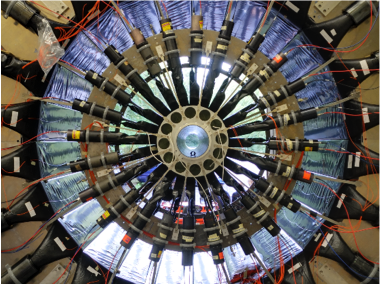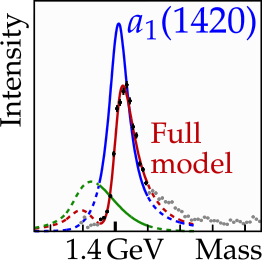COMPASS-II: A QCD Laboratory at CERN
With COMPASS-II CERN enters in the exploration of a new territory: the structure of the proton in multiple dimensions. While COMPASS-I primarily studied the distribution and polarisation of quarks and gluons in the nucleon as a function of the longitudinal momentum carried by the struck quark or gluon, now the focus has shifted to a picture of the proton in terms of additional variables.
It all started in 1988 with the so-called spin crisis that revealed that the proton spin of ½ ℏ is not simply due to the quark spins. It was found that quark spins had a small contribution to proton’s spin. Some theorists proposed that this could be explained by a large polarisation of the gluons that was ‘hiding’ the contribution of the quark spins via the axial anomaly. COMPASS was the first experiment to rule out this scenario by finding that the gluon polarisation is much smaller than the required value of 2 ℏ or more. However, the actual composition of the proton spin is still unexplained.
Now the focus has shifted to orbital motion of quarks and gluons and the related orbital angular momenta, which also contribute to the proton spin. This dynamics cannot be described by the one-dimensional parton distributions studied so far. Its understanding requires a larger, multiple dimensional picture of the proton. In theory a complete description of the nucleon structure is given by the five-dimensional Wigner function, which cannot be measured experimentally. However, integration over space or momentum each yields a class of daughter functions; the former contains the so called transverse momentum dependent functions (TMDs) and the latter the generalised parton distribution functions (GPDs). These functions can be studied experimentally. The GPDs describe the correlation of transverse position and longitudinal momentum of quarks (and gluons) in a hadron. That is why the whole field is often referred to as nucleon tomography. COMPASS will study these GPDs in exclusive processes, such as deeply virtual Compton scattering γ*p --> γp' and hard meson (m) production γ*p --> mp' , where the virtual photon γ* is emitted from a muon of the 190 GeV muon beam and absorbed by a proton in the 2.5 m long liquid hydrogen target. Exclusivity is ensured by the CAMERA proton recoil detector shown in Fig. 1. Data taking is planned for 2016/17.

Figure 1: The CAMERA proton recoil detector
Orbital motion of quarks inevitably incorporates transverse motion and that has been studied by COMPASS in semi-inclusive deep inelastic scattering (SIDIS) of muons off a transversely polarised target, providing clear evidence of a non-vanishing Sivers TMD function, indicating orbital motion. Now COMPASS will probe of universality of this function in another process with the first ever polarised Drell-Yan experiment. An anti-up-quark from an impinging negative pion annihilates with the up-quark of a transversely polarised proton, yielding a muon pair. The theoretical prediction from QCD is that the above mentioned Sivers function changes sign with respect to the SIDIS case. A violation of this important prediction of restricted universality would have major consequences of how QCD calculations are performed. Data taking is ongoing.

Figure 2: a1(1420) resonance: shown are various components and the coherent sum together with the data points.
The other line of approach to study QCD by COMPASS is hadron spectroscopy and pion/kaon polarisability. After the important measurement of the pion polarisability confirming theoretical expectations (see the May Newsletter), COMPASS has presented the discovery of a new particle, a narrow meson, named a1(1420) as reported in the CERN Courier. A new particle with a mass of 1420 MeV comes as a surprise since this mass region has been studied intensively over the last decades. Only because of the largest by far data sample in the world and the large angular acceptance, COMPASS was able to isolate the tiny, about 1 per mille contribution in the data set. The painstaking and complex analysis was led by the COMPASS team of the Technical University of Munich. Several proposals by theorists exist about the nature of the new particle. They interpret the new state as molecule made of known mesons or as a 4-quark state. However, none of the models fully describes the properties of a1(1420).
The Collaboration plans to operate the COMPASS-II experiment at least until the beginning of LS2.
Starting June 1st the collaboration is led by newly elected co-spokespersons: Oleg Denisov from INFN (Torino) and Gerhard Mallot from CERN.
Oleg Denisov was born in 1962 in Dubna (Russia), joined COMPASS from the very beginning (1997) after having participated in two mid-scale experiments in Protvino (JINR-IHEP Neutrino Detector at U-70) and at CERN (OBELIX (PS-201), LEAR, CERN). Oleg is a main proponent and till last year coordinator of the Drell-Yan physics program at COMPASS-II.
Gerhard Mallot was born 1954 in Koblenz (Germany), joined the NMC (NA37) in 1986 in the group of the Mainz University, in 1990 he joined SMC (NA47) and later was the contact person of NA47. He then worked on the COMPASS proposal and joined CERN in 1997 as staff and Technical Coordinator of the COMPASS experiment. From 2003 to 2010 he led the COMPASS Collaboration as co-spokesperson along with Alain Magnon.
